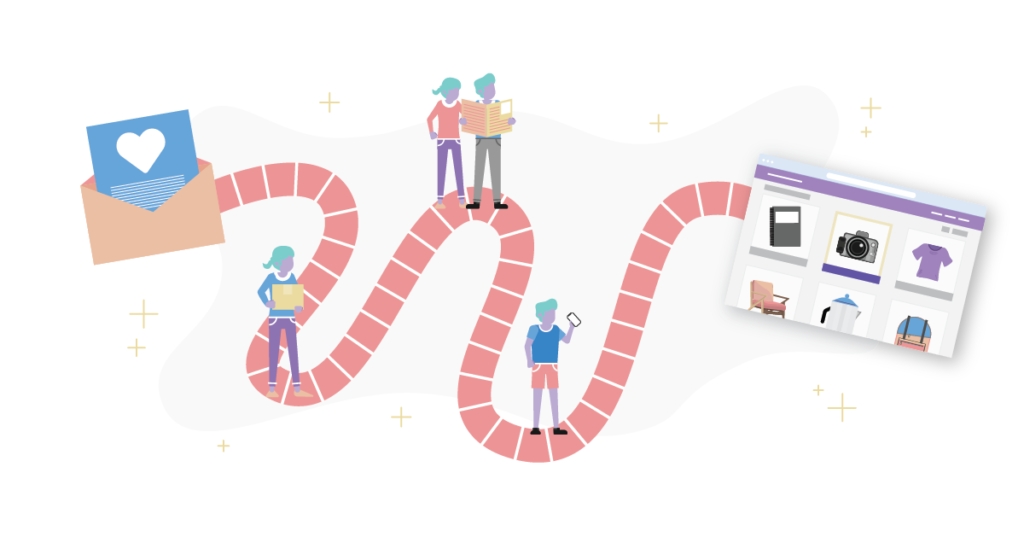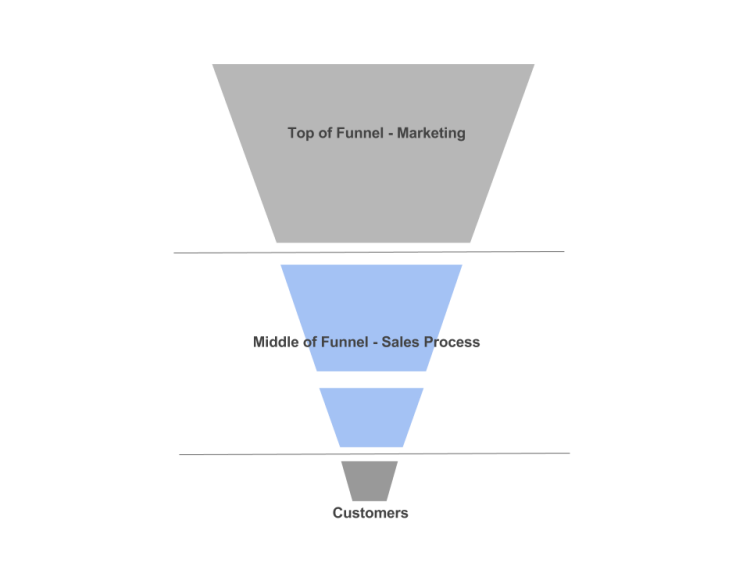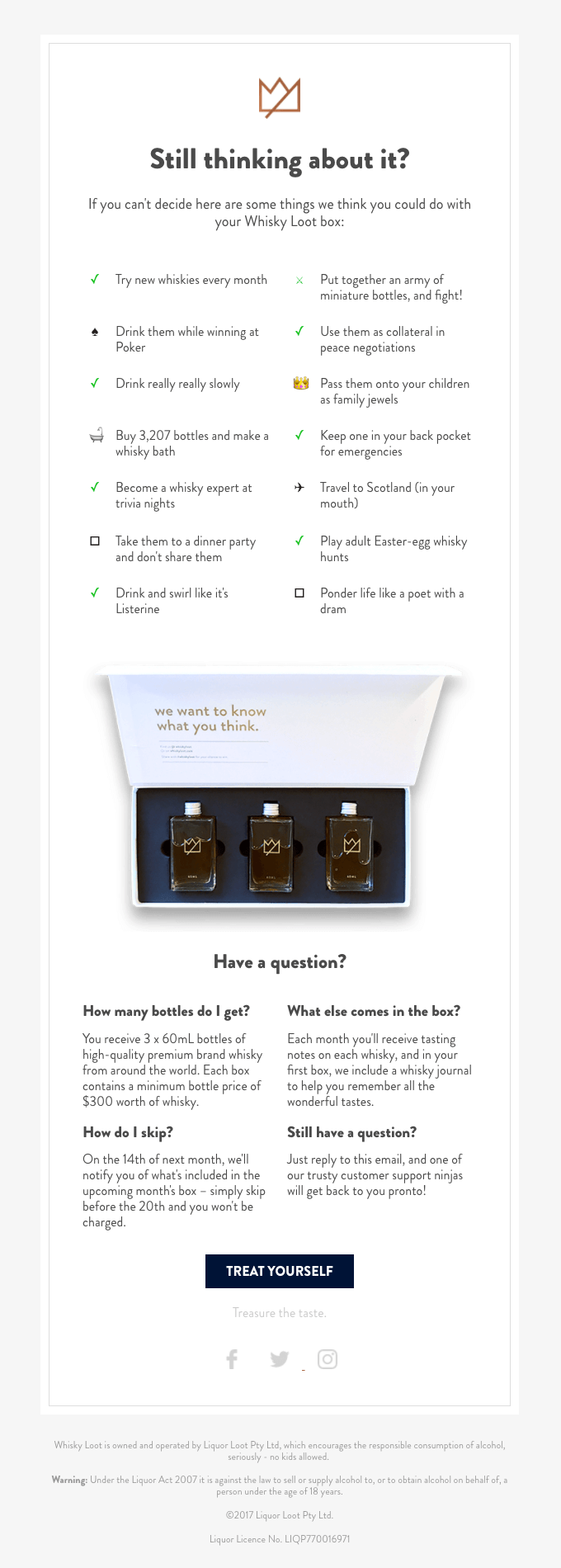Have you been in a situation where you’re scoring lots of new leads and growing your email list like crazy? It’s an amazing feeling, but were you shocked when these leads didn’t turn into more sales — especially after you sent all of those promotional emails?
Even though people love to get emails from brands they’re interested in, a handful of emails sent sporadically over the course of a few days or weeks isn’t enough to convince people to buy. What you need is an email sequence — a series of emails sent consecutively during a set period of time. This way, instead of blasting leads with irrelevant and random emails, you create cohesive, automated email campaigns that keep leads engaged and move them through the sales funnel.
The best thing about email sequences is that you don’t have to spend hours creating new emails every week. Since your goal is to increase your sales, all you have to do is
- create a series of emails that nurture and educate leads,
- schedule when to send each email, and
- sit back and watch your sales grow.
To help you figure out what types of emails to use to move leads through your sales funnel, here’s a look at how the funnel works and what email sequences to use.
Sales funnels: your ticket to increasing revenue
A sales funnel is the journey that leads take from knowing very little about you and your products to becoming loyal customers. The steps within the funnel might change from seller to seller, but there are three main parts:
- Attract new leads at the top of the funnel.
- Retain leads by nurturing them — mid-funnel.
- Convert leads into paying customers — bottom of the funnel.
It’s normal for leads to drop out of the funnel early on — 79% of leads never convert — which is why nurturing the ones that stay is so important. This middle stage of the funnel is where leads begin to trust you and move closer to making a buying decision.
[Source]
With an email sequence, since emails show up at regular intervals, they’re reminders that
- keep your products top of mind,
- encourage leads to choose them, and
- reinforce product benefits and value.
Segment your email list based on how you find new leads so that each group gets relevant information that helps them make a purchase decision. For example, let’s say you sell athleisure and decide to promote your brand at a fitness expo. If people at the event are interested in learning more about getting active and sign up for your email list at your booth, chances are they’ll be receptive to nurture emails that show how your products help them meet this goal.
Leads from the expo might be different from people who sign up for a 10% discount on your website. These folks also care about active living, but saving money is more important to them. You’ll want to send them a different kind of email sequence. Plus, according to Experian, customized transactional emails result in 6X higher revenue and get 8X more opens and clicks.
Tools like Mailchimp and Constant Contact let you segment your subscriber list and create automated email campaigns so you’re sending relevant emails geared toward each group.This, in turn, helps you move more people through your sales funnel to buy something.
Now let’s look at three types of email sequences to send and how to set up each one.
1. Don’t leave your leads hanging — send a welcome email sequence.
Let’s say you run a successful ad series that boosts your lead generation by 20% compared with other tactics you’ve used. You can see that leads are excited about the products and special offer. They sign up for your email list eager to learn more — only to hear crickets. After all the work you do to attract new leads, the last thing you want to do is leave them hanging. Use a welcome email sequence to
- reintroduce yourself and products,
- remind leads about product value,
- explain what to expect from your email list, and
- invite leads to join you on social media if they haven’t already.
Since this early stage is where leads are most likely to drop out of the funnel — they stop opening your emails or they unsubscribe from your list — these first few emails have to maintain the momentum you’ve created so that leads are intrigued and look forward to hearing more.
Here’s an example of a welcome email from Wynd:
This welcome email does a few things well. For example:
- It reminds new leads of the return and free shipping policies. A study by the National Retail Federation found that 75% of shoppers want free shipping.
- It includes a special offer code to encourage leads to act sooner rather than later.
- It restates some of the benefits of using Wynd products.
- It lists the places the brand has been featured. This supports brand authority and positions the products as high quality. The spotlight on media mentions also tells leads they’re going to get their money’s worth if they buy.
- Suggests additional products and includes calls to action (CTAs) to buy.
Since you’ll automate your welcome email sequence, all you have to do is create content that hooks readers, like in the example above, and then set your emails to send when new leads join your email list. It doesn’t matter if one person or 500 people sign up today — they all get the same quality email shortly after sign-up, and they all have the same engaging experience.
How to get started
In your email marketing tool, create a welcome email sequence that includes three or four emails. For example:
- Email #1: Welcome and thank leads for joining your email list.
- Email #2: Highlight popular customer products to give these leads ideas of what to buy.
- Email #3: Highlight key product benefits.
- Email #4: Introduce a special limited-time offer that’s available to first-time customers.
This email sequence is meant to get leads excited and get them to convert and buy.
Set these emails to send a few days apart so there’s time for leads to open and read them. If leads buy something before the end of the welcome series, send them a thank-you email instead of the remaining nurture emails.
2. Keep leads engaged and educated with a lead nurture series.
Once you have your leads’ attention, hold on to it. Do this by nurturing your leads with emails that are both educational and promotional. This series of emails is meant to reinforce your product’s value and teach leads more about what you offer. This type of email sequence moves leads through the sales funnel by revealing more about your products. As leads learn more, the idea is to get them to buy your products rather than the competition’s.
Here are a few types of nurture emails to send:
- Product updates and tips
- Links to blog content that references a solution to a customer pain point
- Product-demo videos
- Limited-time offers
- New-product releases
- Seasonal offers
Here’s an example of a new-product nurture email from Peloton:
There are a few things this nurture email does well:
- It includes a quote from a popular men’s magazine. This builds social proof and begins to build trust with subscribers. After all, quotes from quality sources carry a lot of weight.
- It speaks to the audience’s pain point — finding quality, innovative home-gym equipment.
- It highlights key benefits.
- It outlines next steps.
- It includes a link to FAQs, which can link leads to product pages.
To get leads to put down a deposit on their own Peloton Tread, Peloton can send a series of emails. The email sequence can include the one above, and others that speak to how different the product is from a traditional treadmill. The sequence can also include more quotes from trusted sources, as well as the health benefits of using this machine. All of these features help leads learn more about the equipment and understand how it’ll meet their needs.
How to get started
This is where segmentation comes into play. Based on the different groups you identify, create a series of seven to ten emails that share relevant product information that shows you understand your leads’ needs and have what they need. For leads who want to save money and experience value, your series can include the following:
- Email #1: Select product features and benefits
- Email #2: Reviews from current customers
- Email #3: Video of the product in use
- Email #4: Product updates and industry news
- Email #5: An introduction to special company programs that benefit the real-world community
- Email #6: Testimonials and customer spotlights
- Email #7: A coupon code
Notice how social proof and promotional emails are featured throughout this email sequence. The goal here is to reinforce that leads can save money and get unmatched value at the same time. This email sequence isn’t meant to beat leads over the head with promotional deals since doing so does nothing to build trust.
Save the coupon code or special offer until the end of the series as a final incentive to encourage leads to convert. By that point, leads are probably close to buying, and an incentive is what they need to close the deal.
Also, make sure that the CTAs you use explain what’s expected from leads. In the Peloton example above, the goal is to get leads to reserve their machine. Instead of “Click Here,” the email uses “Reserve Yours” to explain next steps. Keep in mind that not all of your CTAs have to redirect to product pages; they can redirect to content that is relevant and speaks to the points being made in your email.
3. Win back potential customers with an abandoned cart email sequence.
Seventy-six percent of carts are abandoned every year. This accounts for $4.6 trillion in sales that you and other retailers miss out on every year. To recoup some of this lost revenue, use an abandoned cart email sequence. These emails are slightly different from welcome and nurture emails because you’re not always communicating with leads. These are just people who found your products, browsed your page, added products to their carts, and left without checking out. Depending on how far these shoppers get in the checkout process, you won’t have an email address for all of them.
People abandon their carts for lots of reasons. For example, they get distracted before checkout, or they need more time to decide. The fact that they added products to their carts indicates some level of interest in buying. Use an abandoned cart email sequence to get them to come back and complete their transactions.
Here’s an example of a quirky abandoned cart email from Whisky Loot:
What this email does well:
- It uses humor to make the brand more relatable. Whiskey might be considered a “serious” drink with marketing emails not meant to target millennials, but this email has fun and lists new uses for whiskey.
- It includes a few FAQs to convince leads to buy.
- It includes a clear and actionable CTA.
You don’t have to use humor to sell your products. Instead, get to know your audience, and create buyer personas that fit each group. Use humor for some buyer personas, and facts and resources for others.
How to get started
In your email marketing tool, create a sequence that is triggered when prospects add products to their carts and don’t check out. Set up your sequence to send at least three emails:
- Email #1: Reminder of products in abandoned cart
- Email #2: Reminder of product benefits and features
- Email #3: Coupon code
To encourage this type of shopper to convert, include a link that redirects to the cart. Make sure the products the shopper chose are still visible so that the purchase only takes a few clicks. The easier it is for people to shop, the better your chances of closing more sales.
Putting your email sequence into action
You’re leaving money on the table by not coming up with a goal and plan to engage your subscriber list. Your email subscribers want to hear from you — and email marketing has been shown to increase conversions.
An automated email sequence frees up your time so you can focus on other parts of your business. Which is good, considering “automated emails average 70.5% higher open rates and 152% higher click-through rates than other marketing messages,” according to research done by Epsilon Email Institute.
More than anything, figure out what your audience needs, and then set up campaigns that deliver and remind subscribers to buy.







